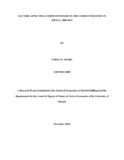| dc.contributor.author | Githinji, Dr Janet M | |
| dc.date.accessioned | 2017-01-06T10:11:00Z | |
| dc.date.available | 2017-01-06T10:11:00Z | |
| dc.date.issued | 2016 | |
| dc.identifier.uri | http://hdl.handle.net/11295/99633 | |
| dc.description.abstract | Background: Contraceptive uptake, knowledge of its use and actual use is lower in the developing world than in the developed world. Data for various contraceptive surveys has not been stratified for the youth, and this data gap masks the burden of low contraceptive uptake among the youth who comprise of 37.2% (women) and 38.7% (men) of the total population in Kenya. The youth form the majority in tertiary institutions like the University of Nairobi. There is evidence that students in universities who are sexually active do not have access to contraception. Medical Student compared to their counterparts have knowledge and access to contraception.
Broad objective: To determine the difference in the rate and determinants of contraceptive uptake between undergraduate students, in College of Health Sciences, and those in College of Humanities and Social Sciences at the University of Nairobi.
Methods
Study design: Comparative cross sectional study, utilizing a mixed methods approach. The mixed methods paradigm started with the quantitative data collection followed by the qualitative.
Setting: College of Health Sciences and the College of Humanities and Social Sciences in the University of Nairobi.
Study population: First and fourth year Undergraduate students from the two Colleges. The key informants were derived from the two colleges in the University of Nairobi. Focus group discussions were composed of only the students from the two colleges.
Sample size: For quantitative data a total of 384 participants (192 in each college), while for qualitative data a total of six focus group discussions (three for each college) and at least 10 in-depth interviews.
Data collection: A self-administered questionnaire was used for quantitative data while a focus group discussion and in-depth interview guides will be used for qualitative data.
Data analysis: For quantitative data, mean, median, Inter-Quartile Range and Standard Deviation were reported for continuous data, while proportions were reported for categorical data. Inferential statistics to show the association of contraceptive and the various explanatory factors were reported using a chi square for categorical data, and t-test for continuous data. Univariate logistic regression and multivariable logistic analysis were carried out. Themes and verbatim quotations were presented for qualitative data.
Relevance of study results: The results from this study were of value as they elaborated on sexual practices among sexually active youth of reproductive age, and highlighted on any challenges they might face in accessing contraceptives.
Results: Fourth year students are more sexually active than first year students, with fourth year students from the CHSS being most active. (P 0.035).Contraceptive use is high among the students. About half of the students use are condoms. Dual method was common among CHS than in CHSS. Fear of side effects was the main reason of non-use. Qualitatively, fear of side effects, peer pressure and deliberate negligence was noted.
Conclusion: Students are sexually active across the colleges and there is still lack of knowledge on various types of contraceptives. There is need for mentorship towards the students beyond orientation week to ensure they achieve they make healthy sexual choices without deferring their career goals.
Recommendation: Health education and awareness, student mentorship, and inclusion of health and se education in the students’ curriculum is of utmost importance. Creation of youth friendly services is vital to ensure that the students have access to procurement, and enhance ability to make informed decisions concerning their sexual choices. | en_US |
| dc.language.iso | en | en_US |
| dc.publisher | University of Nairobi | en_US |
| dc.rights | Attribution-NonCommercial-NoDerivs 3.0 United States | * |
| dc.rights.uri | http://creativecommons.org/licenses/by-nc-nd/3.0/us/ | * |
| dc.subject | Contraception Among Undergraduate University Of Nairobi Students, Nairobi, Kenya | en_US |
| dc.title | A Comparative Study On Uptake And Determinants Of Contraception Among Undergraduate University Of Nairobi Students, Nairobi, Kenya | en_US |
| dc.type | Thesis | en_US |
| dc.description.department | a
Department of Psychiatry, University of Nairobi, ; bDepartment of Mental Health, School of Medicine,
Moi University, Eldoret, Kenya | |


